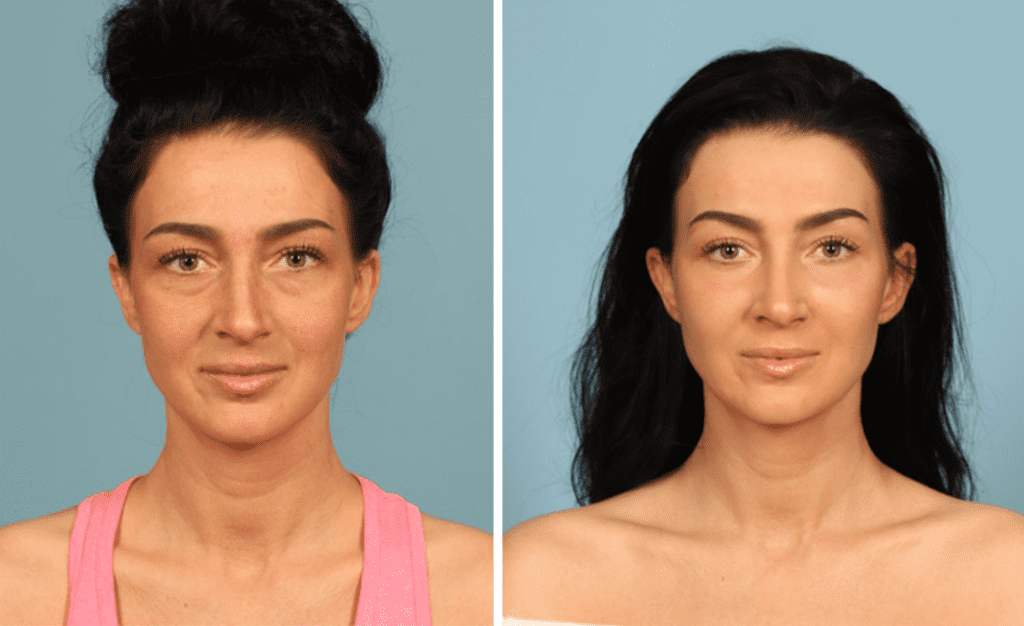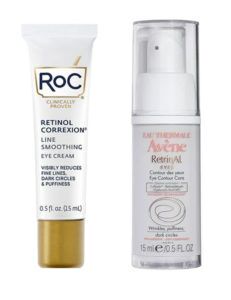
The Best Ways to Fix Under-Eye Hollows, According to Doctors
When it comes to aesthetic eye concerns, “solutions for puffy under-eyes” is one of the highest google searches. But, a close second, and something dermatologists and plastic surgeons are asked about all the time, is “under-eye hollows.” You may hear your doctor refer to this area as the tear trough, and with age, it can appear hollow as we lose volume, collagen and elasticity in our skin. It can make someone look older or more tired than they really are, and who wants to hear “you look tired” when you’re four cups of coffee deep? Here, more on what under-eye hollows are and six different ways to treat them if they bother you.
What are under-eye hollows?
More noticeable on slender faces without as much fat underneath the eyes, hollows can be hereditary or the result of aging and volume loss in the face—“a lack of sleep can make them appear worse, too,” says Fort Lauderdale, FL dermatologist Dr. Igor Chaplik. In the past, they’ve been tough to hide, as well as eliminate altogether, but modern options make the task easier than ever.
Tucson, AZ plastic surgeon Raman C. Mahabir, MD says there are two key components to assess when looking at lower eyes: “There is often a bulge of the lower eyelid and a sunken area where the eyelid meets the cheek—essentially a peak and a trough when viewed from the side. The high and low area creates shadows or dark circles under the eyes, which is a common concern.” Oftentimes, the best solution to achieve a natural-looking result is a combination of fillers, injectables, lasers, and lower eyelid surgery.
Laser Treatments
“If the patient only has a little extra skin and a little bulge, the best option is a CO2 laser to tighten the bulging skin,” says Dr. Mahabir. “I find that this approach is better for younger people.”
Hyaluronic Acid Fillers
In February, the first-ever FDA-approval for a filler being used to treat under-eye hollows was announced: Hyaluronic acid fillers Juvéderm Volbella, which has been used in the U.S. since 2016 for lip enhancement, is now also indicated for the improvement of under-eye hollows in adults over the age of 21. “Under-eye fillers are a great option for those who have hollows, but no visible fat prolapse,” says Beverly Hills, CA ocuplastic surgeon Christopher Zoumalan, MD, who likes working with Volbella for this purpose. “Careful injections to the correct area without overfilling can often create beautiful results.
Bannockburn, IL dermatologist Heather Downes, MD says the filler a doctor recommends for this area is important because “many of them are too thick or cause too much swelling under the eyes.” It is for this reason exactly that New York facial plastic surgeon Dilip D. Madnani, MD likes to use the thinnest fillers possible in this delicate area. “Though Volbella is approved for this area, there are multiple off-label options out there, too, including Belotero Balance, Restylane, RHA 2 and Revanesse Versa,” he says. “I preferentially use Belotero; it comes down to the doctor’s preference.” Dr. Chaplik also prefers Belotero: “I find it to be the most predictable and cohesive and least likely to cause a reaction,” he says.
Beverly Hills, CA facial plastic surgeon Kimberly J. Lee, MD prefers using Restylane for the under-eye area. “All fillers have different qualities, viscosities and characteristics,” she says. “Restylane under the eyes, for me, yields the best results in terms of natural-appearing results, viscosity and duration.”
Placement of the filler is also important. “When placed too superficially under the eyes, fillers can cause a bluish swelling called the Tyndall effect,” says Dr. Downes. “Therefore, I tend to inject fillers under the muscle layer in this area.” In some cases, doctors will suggest filling the cheeks as well, as Covington, LA dermatologist Christel Malinski, MD says the cheeks and tear troughs are intimately related. “If it’s necessary to address both, I most often use a more supportive filler, such as Restylane Lyft or Juvéderm Voluma, in the cheek area, and a softer filler, such as Restylane or Juvéderm Volbella, in the tear trough.”
Dr. Mahabir likes to inject Juvéderm Voluma or Restylane Lyft deep into the face, right next to the bone. “The good news is that these deeper injections rarely show any bruising when done correctly and there is little to no downtime—very little swelling and the patient can essentially go right back to work,” he says. “They should avoid vigorous workouts or contact sports for a few days after, but otherwise, minimal restrictions.”
It’s important to keep in mind that the tear trough can be a very tricky area to fill, so make sure you’re getting safe injections and optimal results by choosing a board-certified dermatologist or plastic surgeon who is properly trained and very familiar with this part of the facial anatomy. “I have seen so many patients who have had filler done very poorly under their eyes,” says Dr. Downes. “These patients were typically injected at a medspa by someone with questionable qualifications. I stress to my patients that a medspa isn’t a bargain when you have to go to a board-certified doctor afterward to have your fillers corrected. Typically, the way we correct or reverse them is by injecting hyaluronidase into the area, which dissolves the filler.”
Fat Grafting
Though he acknowledges HA fillers are best for shallower hollows, Dr. Mahabir’s go-to filler for deeper hollows is the patient’s own fat, which is acquired through a process called fat transfer: fat is taken from one part of the body like the stomach or thighs, cleaned and processed, and then injected in the area under the eyes. “It is permanent, has less risk than fillers because it is their own tissue, and there is a large supply,” he explains. “For people with really deep troughs, this is the best option because the cost of a lot of filler will exceed the cost of the fat grafting.”
Dr. Lee adds that it’s important to understand that not everyone is a candidate for fat grafting under the eyes. “This is because in order for the treatment to be effective, there must be good-quality fat that’s harvested and then grafted. A marathon runner with less than 4 percent body fat, for example, is not a good candidate, but for the right person, it can create a smoother appearance.”

as well as laser resurfacing around her eyes.
Blepharoplasty Surgery
A lower eyelift, aka blepharoplasty, can remove any loose skin under the eyes that makes hollowing look worse, and the fat can be repositioned or added to smooth out sunken skin. “If the patient has more extra skin or more of a bulge, the best option is a lower lid blepharoplasty where the excess fat is either resected or repositioned,“ says Dr. Mahabir.
“Those who actually have under-eye fat prolapse and hollowing are better suited to undergo a lower eyelid blepharoplasty with fat repositioning, where both the prolapsed fat and hollowing are addressed at the same time,” adds Dr. Zoumalan. “If you are considering under eye fillers but are concerned that you may actually be better served by having a lower eyelid blepharoplasty, you should meet with an expert surgeon that performs both lower eyelid blepharoplasty and under eye fillers so that you have the best options presented to you.”
Dr. Madnani says that oftentimes, lower blepharoplasty is combined with fat transfer or hyaluronic acid fillers for optimal results. “There are other nuanced procedures too, such as lower eyelid fat transposition, but these are all advanced techniques that require surgeons with lots of experience treating these areas.” The most important piece of the equation, according to the doctors interviewed here, is doing the right procedure on the right patient.
Potent Skin-Care Products
“If you’re considering undergoing any type of treatment or procedure to address under-eye hollows, you should also be using a topical retinoid,” says Huntington Beach, CA dermatologist David Rayhan, MD. “Topical retinoids, like prescription Retin-A or over-the-counter retinols, will improve the quality of your lower eyelid skin by smoothing small wrinkles and thickening the skin to help reduce the appearance of the hollow or dark circle. This will give you a better result from any treatment.” If OTC products are preferred, we like RoC Retinol Correxion Eye Cream ($18) and Avène RetrinAL EYES ($49).

Makeup Magic
Helen Phillips, Sephora Collection’s national makeup artist, says the best way to mask under-eye hollows is by using various shades of foundation or concealer. “To start, use a foundation or concealer that matches the skin tone under your eyes. This provides a smooth base, as well as helps conceal darkness,” she explains.
“Using a flat concealer brush like Sephora Collection Pro Concealer Brush #71 ($22), lightly sweep a concealer that is at least two to three shades lighter than your skin tone where the deepest part of the hollow is. Using the same brush, lightly blend out the edges but leave the opacity of the light concealer in the center. If you are concerned about the concealer moving or creasing, set it with powder and a damp sponge or powder puff. Then sweep excess powder away with a clean brush.”

Find a Doctor
Find a NewBeauty “Top Beauty Doctor” Near you